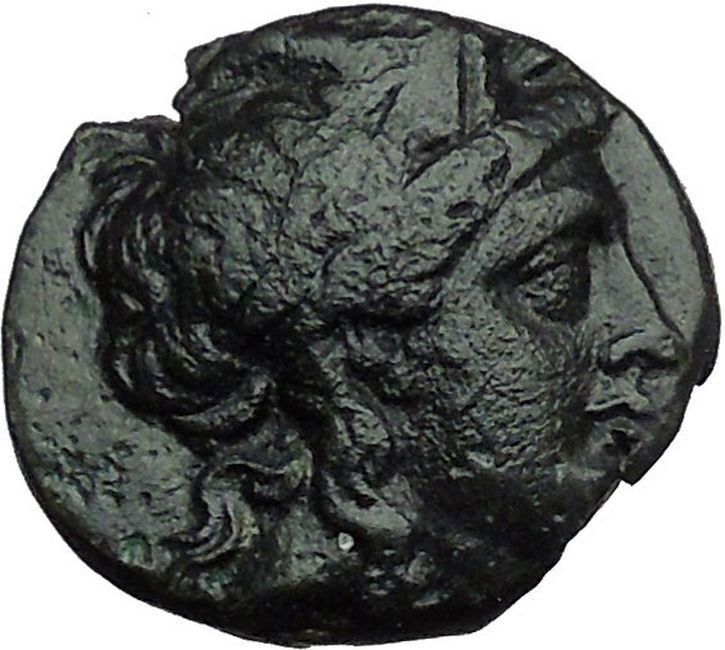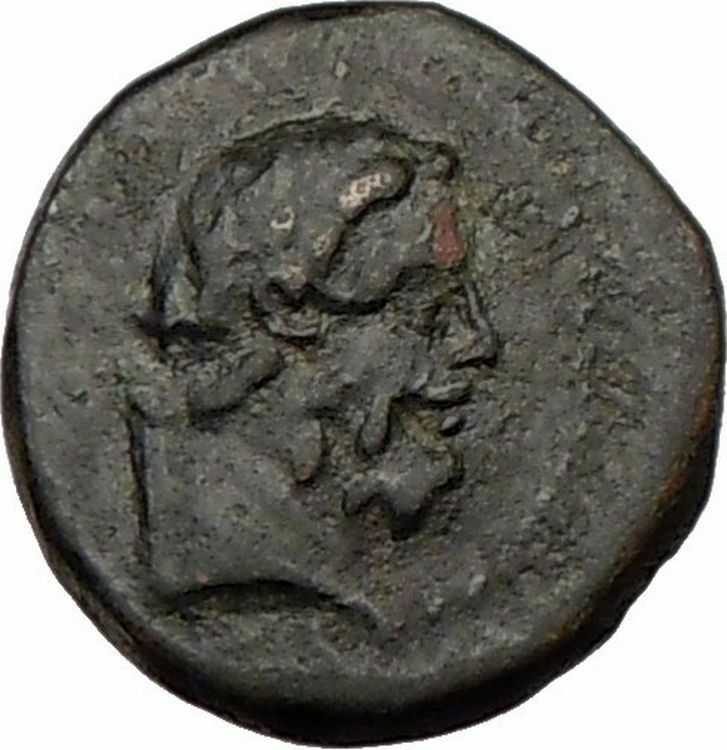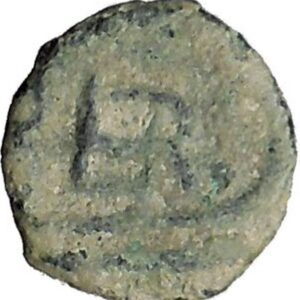|
Greek – Kingdom of
Thrace
–
Lysimachos
– King: 323-281 B.C. –
Bronze 18mm (5.39 grams) Struck circa 305-301 B.C. at Lysimacheia mint
Commemorating the
Olympic Games
Victory of
Philip II
, king 359-336 B.C.
Reference: Price P5 (Philip III); Thompson 2
Head of
Apollo
right, hair bound with tainia.
Youth on
Horse
prancing right, ΦIΛIΠΠΟΥ above;
ΛΥ below; forepart of lion below horse..
* Numismatic Note: Authentic ancient Greek coin of Lysimachos, issuing a coin
similar to that of King Philip II of Macedonia,
father
of Alexander the Great. Intriguing coin referring to the Olympic victory of
Philip II.
One of the most remarkable of the ‘Successors’ of Alexander, Lysimachos was
of Thessalian stock and was a bodyguard of the great Macedonian King. In the
confused period following Alexander’s death he obtained the government of
Thrace, and in 309 B.C. founded his capital city of Lysimacheia where many of
his coins were struck. In 305 B.C. he took the title of King, and four years
later extended his rule over much of Asia Minor following the defeat of
Antigonos the One-eyed at Ipos. His later years were marred by domestic tragedy
and his harsh rule made him unpopular with his subjects. In 281 B.C. Lysimachos,
now aged 80, was attacked by Seleukos of Syria who was only two years his
junior. Lysimachos died fighting at the battle of Korupedion and his kingdom
disappeared with him. But his memory lived on and generations later a number of
mints in the Black Sea area restored his coin types for their autonomous issues.
You are bidding on the exact item pictured,
provided with a Certificate of Authenticity and Lifetime Guarantee of
Authenticity.
History and Meaning of the Coin
During the times of ancient Greeks, horse racing was one of the events
various Greek city-states and kingdoms would have intense competition with each
other, as it was of great prestige to participate. Before the time of Philip II,
the kingdom of Macedonia was considered barbarian and not
Greek. Philip II was the first king of Macedon that was accepted for participation in the
event, which was a great honor all in itself. It was an even greater honor that
Philip’s horses would go on to win two horse-racing events. In 356 B.C., he won
the single horse event and then in 348 B.C. chariot pulled by two horses event.
As a way to proudly announce, or what some would say propagandize these
honors, Philip II placed a reference to these great victories on his coins
struck in all three metals of bronze, silver and gold. The ancient historian,
Plutarch, wrote “[Philip of Macedon] … had victories of his chariots at
Olympia stamped on his coins.”
Lysimachus (Greek:
Λυσίμαχος, Lysimachos; 360 BCE – 281 BCE) was a
Macedonian
officer and
diadochus
(i.e. “successor”) of
Alexander the Great
, who became a
basileus
(“king”) in 306 BCE, ruling
Thrace
,
Asia Minor
and
Macedonia
.
//
Early
career
Lysimachus was born in 362/361 BC, the son of the
Thessalian
Agathocles from
Crannon
. He was granted citizenship in
Macedon
and was educated at the court in
Pella
. He was
probably appointed
Somatophylax
during the reign of Philip II.[1]
During Alexander’s
Persian
campaigns, he was one of his immediate bodyguards. In
324 BCE
, in Susa, he was crowned in recognition for his actions in India.[2]
After Alexander’s death in 323 BCE, he was appointed to the government of Thrace
as strategos
.[3]
Diadochi
In 315 BCE, he joined
Cassander
,
Ptolemy
and
Seleucus
against
Antigonus
, who, however, diverted his attention by stirring up Thracian and
Scythian
tribes against him. In 309 BCE, he founded
Lysimachia
in a commanding situation on the neck connecting the Chersonese
with the mainland. He followed the example of Antigonus in taking the title of
king.[4]
In 306 or 305, he assumed the title of “King”, which he held until his death
at Corupedium in 282/1.[5]
In 302, when the second affiance between Cassander, Ptolemy and
Seleucus was made, Lysimachus, reinforced by troops from Cassander, entered Asia
Minor, where he met with little resistance. On the approach of Antigonus he
retired into winter quarters near
Heraclea
, marrying its widowed queen
Amastris
, a
Persian princess. Seleucus joined him in 301 BCE, and at the
battle of Ipsus
Antigonus was defeated and slain. His dominions were divided
among the victors. Lysimachus share was
Lydia
,
Ionia
,
Phrygia
and
the north coast of Asia Minor.[4]
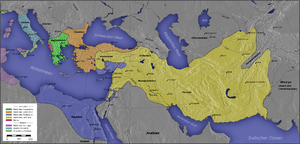
Kingdom of Lysimachus Other
diadochi
Kingdom of
Cassander
Kingdom of
Seleucus_I_Nicator
Kingdom of
Ptolemy
Epirus
Other
Carthage
Rome
Greek
colonies
Feeling that Seleucus was becoming dangerously great, Lysimachus now allied
himself with Ptolemy, marrying his daughter
Arsinoe II of Egypt
. Amastris, who had divorced herself from him, returned
to Heraclea. When Antigonus’s son
Demetrius I of Macedon
renewed hostilities (297 BCE), during his absence in
Greece
,
Lysimachus seized his towns in Asia Minor, but in 294 BCE concluded a peace
whereby Demetrius was recognized as ruler of
Macedonia
. He tried to carry his power beyond the
Danube
, but was
defeated and taken prisoner by the
Getae
king
Dromichaetes
(Dromihete),
who, however, set him free on amicable terms. Demetrius subsequently threatened
Thrace, but had to retire due to a sudden uprising in
Boeotia
, and
an attack from the king
Pyrrhus
of Epirus
.
In 288 BCE, Lysimachus and
Pyrrhus
in turn invaded
Macedonia
, and drove Demetrius out of the country. Lysimachus left
Pyrrhus
in possession of
Macedonia
with the title of king for around seven months before Lysimachus
invaded. For a short while the two ruled jointly but in 285 BCE Lysimachus
expelled Pyrrhus.[6]
Later
years
Domestic troubles embittered the last years of Lysimachus’s life. Amastris
had been murdered by her two sons; Lysimachus treacherously put them to death.
On his return Arsinoe asked the gift of Heraclea, and he granted her request,
though he had promised to free the city. In 284 BCE Arsinoe, desirous of gaining
the succession for her sons in preference to
Agathocles
(the eldest son of Lysimachus), intrigued against him with the
help of her brother
Ptolemy Keraunos
; they accused him of conspiring with Seleucus to seize the
throne, and he was put to death.
This atrocious deed of Lysimachus aroused great indignation. Many of the
cities of Asia revolted, and his most trusted friends deserted him. The widow of
Agathocles fled to Seleucus, who at once invaded the territory of Lysimachus in
Asia. In 281 BCE, Lysimachus crossed the
Hellespont
into Lydia
, and at the decisive
Battle of Corupedium
was killed. After some days his body was found on the
field, protected from birds of prey by his faithful dog.[7]
Lysimachus’s body was given over to his son
Alexander
, by whom it was interred at
Lysymachia
.
Thrace (demonym
Thracian
/
ənθreɪʃⁱˈ/;
Bulgarian
:
Тракия, Trakiya,
Greek
: Θράκη,
Thráki,
Turkish
:
Trakya) is a historical and geographic area in southeast
Europe
. As a geographical concept, Thrace
designates a region bounded by the
Balkan Mountains
on the north,
Rhodope Mountains
and the
Aegean Sea
on the south, and by the
Black Sea
and the
Sea of Marmara
on the east. The areas it
comprises are southeastern
Bulgaria
(Northern
Thrace), northeastern
Greece
(Western
Thrace), and the European part of
Turkey
(Eastern
Thrace). The biggest part of Thrace is part of present-day Bulgaria.
In Turkey, it is also called
Rumelia
. The name comes from the
Thracians
, an ancient
Indo-European
people inhabiting Southeastern
Europe.
The historical boundaries of Thrace have varied. Noteworthy is the fact that,
at an early date, the
ancient Greeks
employed the term “Thrace” to
refer to all of the territory which lay north of
Thessaly
inhabited by the
Thracians
,[1]
a region which “had no definite boundaries” and to which other regions (like
Macedonia
and even
Scythia
) were added.[2]
In one ancient Greek source, the very Earth is divided into “Asia, Libya, Europa
and Thracia”.[2]
As the knowledge of world geography of the Greeks broadened, the term came to be
more restricted in its application: Thrace designated the lands bordered by the
Danube
on the north, by the Euxine Sea (Black
Sea) on the east, by northern
Macedonia
in the south and by the
Illyrian
lands (i.e.
Illyria
) to the west.[2]
This largely coincided with the Thracian
Odrysian kingdom
, whose borders varied in time.
During this time, specifically after the Macedonian conquest, the region’s old
border with Macedonia was shifted from the
Struma River
to the
Mesta River
.[3][4]
This usage lasted until the Roman conquest. Henceforth, (classical) Thrace
referred only to the tract of land largely covering the same extent of space as
the modern geographical region. In its early period, the
Roman province of Thrace
was of this extent,
but after the administrative reforms of the late 3rd century, Thracia’s much
reduced territory became the six small provinces which constituted the
Diocese of Thrace
. The medieval
Byzantine
theme
of
Thrace
contained only what today is
Eastern Thrace
.
The largest cities of Thrace are:
İstanbul
(European side),
Plovdiv
,
Burgas
,
Stara Zagora
,
Haskovo
,
Edirne
,
Çorlu
and
Tekirdag
.
Most of the Bulgarian and Greek population are Christians, while most of the
Turkish inhabitants of Thrace are Muslims.
Thrace in
ancient Greek mythology
Ancient Greek mythology
provides them with a
mythical ancestor, named
Thrax
, son of the war-god
Ares, who was said to reside in Thrace. The Thracians appear in
Homer
‘s
Iliad
as
Trojan allies, led by
Acamas
and
Peiros
. Later in the Iliad,
Rhesus
, another Thracian king, makes an
appearance. Cisseus
, father-in-law to the Trojan elder
Antenor
, is also given as a Thracian king.
Homeric Thrace was vaguely defined, and stretched from the River
Axios
in the west to the
Hellespont
and
Black Sea
in the east. The
Catalogue of Ships
mentions three separate
contingents from Thrace: Thracians led by Acamas and Peiros, from
Aenus
;
Cicones
led by
Euphemus
, from southern Thrace, near
Ismaros
; and from the city of
Sestus
, on the Thracian (northern) side of the
Hellespont, which formed part of the contingent led by
Asius
. Greek mythology is replete with Thracian
kings, including
Diomedes
,
Tereus
,
Lycurgus
,
Phineus
,
Tegyrius
,
Eumolpus
,
Polymnestor
,
Poltys
, and
Oeagrus
(father of
Orpheus
). In addition to the tribe that Homer
calls Thracians, ancient Thrace was home to numerous other tribes, such as the
Edones
,
Bisaltae
,
Cicones
, and
Bistones
.
Thrace is also mentioned in Ovid’s Metamorphoses in the episode of
Philomela
, Procne, and
Tereus
. Tereus, the King of Thrace, lusts after
his sister-in-law, Philomela. He kidnaps her, holds her captive, rapes her, and
cuts out her tongue. Philomela manages to get free, however. She and her sister,
Procne, plot to get revenge, by killing Itys (son of Tereus and Procne) and
serving him to his father for dinner. At the end of the myth, all three turn
into birds—Procne, a swallow; Philomela, a nightingale; and Tereus, a
hoopoe
.
History
Ancient history
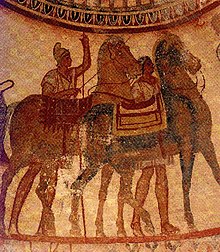
Thracian Tomb of Kazanlak
The indigenous population of Thrace was a people called the
Thracians
, divided into numerous tribal groups.
Thracian troops were known to accompany neighboring ruler
Alexander the Great
when he crossed the
Hellespont
which abuts Thrace, and took on the
Persian Empire
of the day.
The Thracians did not describe themselves as such and Thrace and
Thracians are simply the names given them by the Greeks.[5]
Divided into separate tribes, the Thracians did not manage to form a lasting
political organization until the
Odrysian state
was founded in the 4th century
BC. Like Illyrians
, Thracian tribes of the mountainous
regions fostered a locally ruled warrior tradition, while the tribes based in
the plains were purportedly more peaceable. Recently discovered funeral mounds
in Bulgaria suggest that Thracian kings did rule regions of Thrace with distinct
Thracian national identity.
During this period, a subculture of
celibate
ascetics
called the
Ctistae
lived in Thrace, where they served as
philosophers, priests and prophets.
Medieval history
By the mid 5th century, as the Roman Empire began to crumble, Thracia fell
from the authority of Rome and into the hands of Germanic tribal rulers. With
the fall of Rome, Thracia turned into a battleground territory for the better
part of the next 1,000 years. The eastern successor of the
Roman Empire
in the Balkans, the
Byzantine Empire
, retained control over Thrace
until the 8th century when the northern half of the entire region was
incorporated into the
First Bulgarian Empire
. Byzantium regained
Thrace in the late 10th century and administered it as a
theme
, until the Bulgarians regained
control of the northern half at the end of the 12th century. Throughout the 13th
century and the first half of the 14th century, the region was changing in the
hands of the Bulgarian and the Byzantine Empire(excl. Constantinopole). In 1265
the area suffered a Mongol raid from the
Golden Horde
, led by
Nogai Khan
. In 1352, the
Ottoman
Turks
conducted their first incursion into the
region subduing it completely within a matter of two decades and occupying it
for five centuries.
Modern history
With the
Congress of Berlin
in 1878, Northern Thrace was
incorporated into the semi-autonomous Ottoman province of
Eastern Rumelia
, which united with Bulgaria in
1885. The rest of Thrace was divided among Bulgaria, Greece and Turkey at the
beginning of the 20th century, following the
Balkan Wars
,
World War I
and the
Greco-Turkish War
. Today Thracian is a
strong regional identity in Greece, Turkey, Bulgaria and other neighbouring
countries.
Famous Thracians and people from Thrace
- A number of
Roman emperors
of the 3rd-5th century were
of Thraco-Roman
backgrounds (Maximinus
Thrax,
Licinius
,
Galerius
,
Aureolus
,
Leo the Thracian
, etc.). These emperors
were elevated via a military career, from the condition of common soldiers
in one of the
Roman legions
to the foremost positions of
political power
.

Apollo Belvedere
,
ca. 120–140 CE
Apollo is one of the most important and complex of the
Olympian deities
in
ancient Greek
and
Roman religion
,
Greek
and
Roman mythology
, and
Greco
–Roman
Neopaganism
. The ideal of the
kouros
(a beardless, athletic youth),
Apollo has been variously recognized as a god of light and the sun, truth and
prophecy, healing, plague, music, poetry, and more. Apollo is the son of
Zeus and Leto
, and has a twin sister, the chaste
huntress Artemis
. Apollo is known in Greek-influenced
Etruscan mythology
as Apulu.
As the patron of Delphi
(Pythian Apollo), Apollo was an
oracular
god—the prophetic deity of the
Delphic Oracle
. Medicine and healing are
associated with Apollo, whether through the god himself or mediated through his
son Asclepius
, yet Apollo was also seen as a god
who could bring ill-health and deadly
plague
. Amongst the god’s custodial charges,
Apollo became associated with dominion over
colonists
, and as the patron defender of herds
and flocks. As the leader of the
Muses (Apollon Musegetes) and director of their choir, Apollo
functioned as the patron god of music and poetry.
Hermes
created the
lyre for him, and the instrument became a common
attribute of Apollo
. Hymns sung to Apollo were
called paeans
.
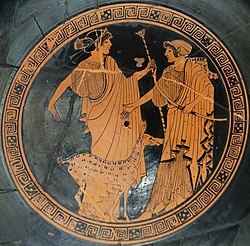
Apollo (left) and
Artemis
.
Brygos
(potter signed), Tondo of an
Attic red-figure cup c. 470 BC,
Musée du Louvre
.
In Hellenistic times, especially during the 3rd century BCE, as Apollo
Helios he became identified among Greeks with
Helios
,
Titan
god of the sun
, and his sister Artemis
similarly equated with
Selene
, Titan
goddess of the moon
In Latin texts, on the
other hand,
Joseph Fontenrose
declared himself unable to
find any conflation of Apollo with
Sol
among the
Augustan poets
of the 1st century, not even in
the conjurations of Aeneas
and
Latinus
in
Aeneid
XII (161–215). Apollo and Helios/Sol
remained separate beings in literary and mythological texts until the 3rd
century CE.
Origins

The Omphalos
in the Museum of
Delphi
.
The cult centers of Apollo in Greece,
Delphi
and
Delos
, date from the 8th century BCE. The Delos
sanctuary was primarily dedicated to
Artemis
, Apollo’s twin sister. At Delphi,
Apollo was venerated as the slayer of
Pytho
. For the Greeks, Apollo was all the Gods
in one and through the centuries he acquired different functions which could
originate from different gods. In
archaic Greece
he was the
prophet
, the oracular god who in older times
was connected with “healing”. In
classical Greece
he was the god of light and of
music, but in popular religion he had a strong function to keep away evil.
From his eastern-origin Apollo brought the art of inspection from “symbols
and omina
” (σημεία και τέρατα : semeia kai
terata), and of the observation of the
omens of the days. The inspiration oracular-cult was probably
introduced from Anatolia
. The
ritualism
belonged to Apollo from the
beginning. The Greeks created the
legalism
, the supervision of the orders of the
gods, and the demand for moderation and harmony. Apollo became the god of
shining youth, the protector of music, spiritual-life, moderation and
perceptible order. The improvement of the old
Anatolian
god, and his elevation to an
intellectual sphere, may be considered an achievement of the
Greek
people.
Healer and
god-protector from evil
The function of Apollo as a “healer” is connected with
Paean
, the physician of the Gods in the
Iliad
, who seems to come from a more
primitive religion. Paeοn is probably connected with the
Mycenean
Pa-ja-wo, but the etymology is the
only evidence. He did not have a separate cult, but he was the personification
of the holy magic-song sung by the magicians that was supposed to cure disease.
Later the Greeks knew the original meaning of the relevant song “paean”. The
magicians were also called “seer-doctors”, and they used an ecstatic prophetic
art which was used exactly by the god Apollo at the oracles.
In the Iliad, Apollo is the healer under the gods, but he is also the
bringer of disease and death with his arrows, similar to the function of the
terrible
Vedic
god of disease
Rudra
.He sends a terrible plague to the
Achaeans
. The god who sends a disease can also
prevent from it, therefore when it stops they make a purifying ceremony and
offer him an “hecatomb” to ward off evil. When the oath of his priest appeases,
they pray and with a song they call their own god, the beautiful Paean.
Some common epithets of Apollo as a healer are “paion” , “epikourios”,
“oulios”, and “loimios” . In classical times, his strong function in popular
religion was to keep away evil, and was therefore called “apotropaios” and
“alexikakos” , throw away the evil).
In later writers, the word, usually spelled “Paean”, becomes a
mere epithet of Apollo in his capacity as a god of
healing
.
Homer illustrated Paeon the god, and the song both of
apotropaic
thanksgiving or triumph. Such songs
were originally addressed to Apollo, and afterwards to other gods: to
Dionysus
, to Apollo
Helios
, to Apollo’s son
Asclepius
the healer. About the 4th century
BCE, the paean became merely a formula of adulation; its object was either to
implore protection against disease and misfortune, or to offer thanks after such
protection had been rendered. It was in this way that Apollo had become
recognised as the god of music. Apollo’s role as the slayer of the
Python
led to his association with battle and
victory; hence it became the
Roman
custom for a paean to be sung by an army
on the march and before entering into battle, when a fleet left the harbour, and
also after a victory had been won.
Oracular cult

Columns of the
Temple of Apollo
at Delphi, Greece.
Unusually among the Olympic deities, Apollo had two cult sites that had
widespread influence: Delos
and
Delphi
. In cult practice,
Delian Apollo
and
Pythian Apollo
(the Apollo of Delphi) were so
distinct that they might both have shrines in the same locality.Apollo’s
cult
was already fully established when written
sources commenced, about 650 BCE. Apollo became extremely important to the Greek
world as an oracular deity in the
archaic period
, and the frequency of
theophoric names
such as Apollodorus or
Apollonios and cities named Apollonia testify to his popularity.
Oracular sanctuaries to Apollo were established in other sites. In the 2nd and
3rd century CE, those at
Didyma
and
Clarus
pronounced the so-called “theological
oracles”, in which Apollo confirms that all deities are aspects or servants of
an
all-encompassing, highest deity
. “In the 3rd
century, Apollo fell silent.
Julian the Apostate
(359 – 61) tried to revive
the Delphic oracle, but failed
|











